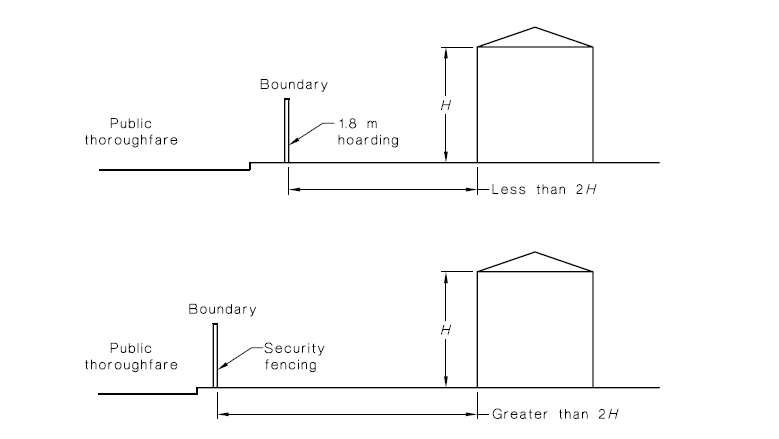Demolition is defined as the complete or partial dismantling of a building or structure, by pre-planned and controlled methods or procedures.
An application for a permit to demolish or remove a building must be accompanied with an:
- Outline/description of the subject building
- Site plan
- Details of hoardings/barricades/crossings etc
- Written description of the demolition procedures
- Evidence of the knowledge and experience of the demolisher
Demolition must not commence until
- The precautionary measures have been inspected and approved by the Relevant Building Surveyor (measures outlined below)
- A Section 29a – Demolition Consent is obtained from the Relevant Authority (when required)
- Protection works notices are served (if the Building Surveyor considers it appropriate)
A Section 29A, Report & Consent must be obtained from the Relevant Authority if:
- More than half the volume of the building will be demolished
- The demolition is of any part of a façade of a building if that façade faces the street
‘Facade’ includes an external wall, including any veranda, balcony, balustrade or architectural feature attached to or forming part of an external wall; or a part of a roof; or a chimney.
‘Street’ includes road, highway, carriageway, square and court and excludes laneways, footways, rights of way and driveways.
The demolition of a building shall be completed in the reverse order to that of its construction. It should be progressive, storey by storey, having regard to the type of construction and no part of any structure should be left unsupported or unattended in such a condition that it may collapse or become dangerous.
Health and Safety
People walking or driving past must be protected from falling objects, projections, dust, noise etc at all times during demolition. Additionally, public safety must be maintained by providing street closures, hoardings and scaffoldings (Regulation 604 – Protection of the public)
Lighting
Lighting of public places adjoining the demolition site should be provided so that obstructions resulting from the demolition are clearly visible at all times.
Falling Materials
Procedures must be taken to prevent materials from falling outside the boundaries of the demolition site. Where the site adjoins a public thoroughfare, the common boundary shall be fenced and provided with protective structures
Security Fencing
Fencing should be provided around the perimeter of the demolition site to prevent unauthorised entry during demolition
Hoardings
Where the demolition site adjoins a public thoroughfare, the common boundary between them must be fenced for its full length with a hoarding, unless the least horizontal distance between the common boundary and the nearest parts of the structure is greater than twice the height of the structure (see below diagram). The hoardings shall be constructed of solid materials to a height of not less that 1.8m adjacent to the thoroughfare.

Warning Notices
Notices displaying the words ‘WARNING DEMOLITION IN PROGRESS’ or similar must be fixed to the fencing at to warn the public.
Scaffolding
The scaffolding shall:
- enclose the work area;
- be impenetrable and able to withstand the impact of rubble; and
- be maintained and inspected on a regular basis.
Overhead protection
Where a demolition site adjoins a public thoroughfare with a footpath alongside the common boundary then, in addition to the hoarding, the footpath shall be covered by an overhead protective structure and the facing facade protected by heavy-duty scaffolding.
Fire Protection
A fire hydrant service or a fire hose reel service that is in a building must be available at all times during the demolition of the building, so that all remaining storeys not under demolition are served.
Hazardous substances
Audit:
A competent person shall determine the presence of hazardous substances or conditions, and a Hazardous Substances Management Plan shall be prepared (to include location ad quantity of each substance and methods of controlling, monitoring and removal).
Removal:
All site personnel must be immediately informed of the presence of any hazardous substances and appropriate control measures must be implemented. No demolition shall proceed until the risks have been assessed by a competent person
Protection of Adjoining Buildings and the Environment
- Consideration shall be given to the use of shoring, and underpinning, and to changes in the soil conditions as a result of demolition, and the appropriate action must be taken
- The effects of vibration and concussion on adjoining buildings and their occupants shall be minimised
- Burning shall not be used as a method of demolition
- Techniques of demolition shall minimize the release of dust into the environment (accumulation of dust to be controlled by vacuuming or hosing down)
Related Posts
November 12, 2015
Application of the DDA
The Disability Discrimination Act makes it illegal to discriminate against a person on the basis of…
September 15, 2014
Choose the right Building Surveyor
Getting the right Building Surveyor on board makes all the difference. Grimbos Building Surveyors…
February 24, 2015
The importance of the MFB during apartment design
Over the weekend, a fire broke out on the 50th floor of the 86 story Torch Tower building in Dubai…

